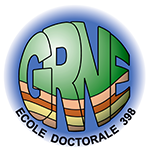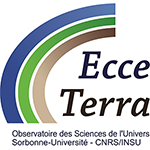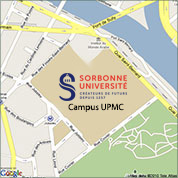Séminaires ISTeP - Marta Gasparrini
From conventional characterization towards quantitative carbonate diagenesis: constraints from clumped isotope thermometry, U-Pb chronometry and sedimentary stylolites imagery – case of the Dogger reservoirs from the Paris Basin.
Diagenesis may strongly modify primary petrophysical properties of carbonate rocks via processes of cementation, replacement, fracture healing etc. One of the challenges of conducting diagenesis characterization studies is to quantify thermal conditions and ages of these modifications to assess their occurrence in time and space (paragenesis). This has an impact on the confidence of subsequent basin models, whose accuracy also critically affects the understanding of basin evolution and the simulations of hydrocarbon generation and fluids (water, oil, gas) migration.
Chemical compaction is a diagenetic process affecting sedimentary series during burial that may result in dissolution of important rock volumes and porosity reduction along Bedding Parallel Stylolites (BPS). The factors controlling the BPS development and the total thickness of carbonate dissolved are still not fully understood and are at present not taken into account in thermal or flow simulations.
New promising methods are developing to face these problematics. In particular, the carbonate clumped isotopes thermometer (Δ47) allows temperature estimations that overcome common carbonate petrographic limitations and the U-Pb analyses by LA-ICP-MS allows to date carbonate crystallisation directly on thin sections by requiring low U contents. On the other hand, more quantitative approaches to evaluate chemical compaction can be applied and include statistics, image analysis and morphometry of the stylolites traces.
A reservoir unit of the Paris Basin from sub-surface cores (Bathonian Sup. –Callovian Inf.; Calcaire de Comblanchien) was chosen to apply these techniques. The aim was to quantify both absolute temperature and timing of four different cementation phases (carbonate thermo-chronology) and to estimate chemical compaction and maximum paleo-dephts experienced by the host carbonates (stylolites).
03/02/2017, Salle Fourcade (55/56, 4ème étage) à 12h30
Egalement dans la rubrique
- Séminaire ISTeP - Tatsuhiko Kawamoto
- Séminaire ISTeP - Boris Chauviré
- Séminaire ISTeP - Jacques Bourgois
- Séminaire ISTeP - Michael Hermoso
- Séminaire ISTeP - Alexis Nutz
- Séminaire ISTeP - Chloé Loury
- Séimnaire ISTeP - Silvio Ferrero
- Séminaire ISTeP - Simon Andrieu
- Séminaire ISTeP - Johan Le Goff
- Séminaire ISTeP - Benjamin Bruneau
- Séminaire ISTeP - Amandine Prelat
- Séminaire ISTeP - Kevin Mahan
- Séminaire ISTeP - Damien Do Couto
- Séminaire ISTeP - Silvia Omodeo Salé
- Séminaire ISTeP - Céline Ducassou
- Séminaire ISTeP - Jean Nizou
- Séminaire ISTeP - Charlotte Ribes
- Séminaire ISTeP - Yohann Poprawski
- Séminaire ISTeP - Yael Sagy
- Séminaire ISTeP - Diane Bonnemains
- Séminaire ISTeP - Muriel Laubier
Chiffres clés (Mars 2025)
L'ISTeP comprend 131 membres dont :
Permanents (66)
- Professeurs : 17 (+2 PAST)
- Maîtres de conférence : 26
- Directeurs de recherche CNRS : 1
- Chargés de recherche CNRS : 1
- ITA : 19
Personnels non permanents (65)
- Collaborateurs bénévoles / émérites : 17
- Chaire de professeur junior : 1
- Enseignants-chercheurs contractuel : 2
- 1 MCF accueil en délégation
- ATER et Post-Docs : 9
- Doctorants : 32
- ITA-BIATSS : 3





